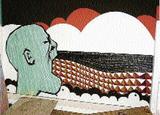

Photos by Michael Robinson
LEFT: A section of 'This Side Up', an installation by Patasha McLean.
RIGHT: 'Residual History' (Shrouded in Mystery) by O'Dwayne Wilson.Michael Robinson, Gleaner Writer
An unlikely pairing of disciplines makes for an interesting display at the Edna Manley College (EMC). The school's Cag(e) Gallery opened the 'Best of the 2008 Final Year Show' exhibit on Tuesday, featuring the work of two creators from this year's crop of graduates.
Rostered as part of the currently ongoing art festival, Kingston on the Edge (KOTE), the exhibition sheds light on the work of O'Dwayne Wilson and Patasha McLean.
Both artists seem to share a burning desire to say something about the world around them. In Wilson's case, his work tackles the issue of uniforms and the offices they represent. A painter who considers himself 'an artistic vigilante', his work depicts garments from such controversial occupations as the priesthood and the police force. Uniforms, says O'Dwayne, represent "what people should be".
Wilson's largely representational renderings are strengthened by good draughts-manship. He departs from strict representation by choosing to work with unconventional media.
Two contorted nudes titled 'Body Shot' (Sketch 1 and Sketch 2) show an under-standing of form and volume through the measured use of highlights amid heavy charcoal rendering on ply. In 'Residual History (Shrouded in Mystery)', priestly garments are central to the image, standing ghostly beside a disembodied head and a bishop depicted across separated planks that resemble a picket fence.
The aim, says the artist, is to "separate who they are from what they are". To this end, bodies are dehumanised by the separation of body parts and the uniforms are imbued with an eerie sentience. If, as Wilson opines, institutions absorb people, then this body of work is his wake-up call.
Visual Communication, which used to be known as Graphic Design, is Patasha McLean's chosen area of study. Judging by her installation, however, she has many facets and a broad vision. The work tagged 'This Side Up' is largely inspired by a series of interviews with homeless people. "Each piece," says McLean, "is based on someone's story."
Her installation is a giant cardboard box, a replica of those commonly used as shelter by the indigent, filled and surrounded by portraits, writings and mixed media pieces. Patasha explains that she used actual garbage to create much of what appears to be a haphazard construction. Contrary to appearances, however, every aspect of the piece was carefully planned and constructed.
Depicting homelessness
Patasha's giant box has a hole in the ceiling, through which hundreds of watts of light pour in, creating a heated environment. The intention is to suggest a discomfort echoing the negative physical aspects of homelessness.
McLean's use of cheerful colours and a graphic drawing style akin to comic art belies the sober nature of the work's content. It is only upon closer inspection that viewers are able to discern the messages therein. The lesson here is one that must have been learnt by the artist herself, as she says the experience taught her there is more to homelessness than meets the eye. "There are different kinds of homeless people," she shares. "Some of them are intellectuals, some are prostitutes and some are people who have lost their jobs.
"There are deportees," she continues, "some are retirees who were sending money back home from the States, only to come home and find everything has been spent off. And then there are the little boys who are all blinged out until you notice they're not wearing any shoes." Clearly, one thing to be taken from this body of work is that appearances are nothing to go by.
Artist with a vision
The direction evident in the work of these emerging artists is encouraging. Their eyes and their minds appear to be wide open. Both McLean and Wilson show a real concern for societal issues as well as a creative impetus to think outside the box (no pun intended).
Kudos to KOTE for promoting the efforts of Jamaica's well-known and soon-to-be-well-known creators in all genres. Omar Francis, one of the festival's organisers, passed through the EMC exhibit on his way to the poetry presentation across campus. His take on KOTE's second incarnation: "It's been fantastic actually, better than last year in terms of the vibes and the turnout."
The future of the creative scene in Jamaica is looking good.

